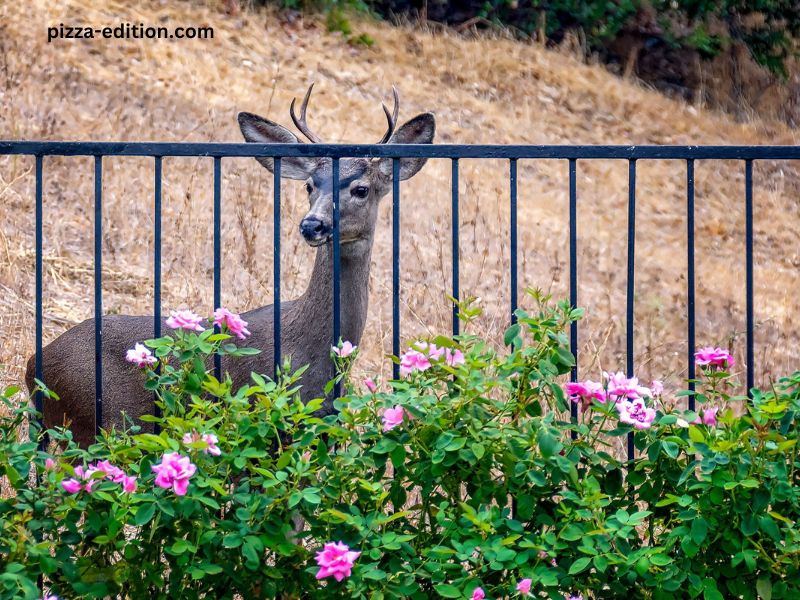Gardening is a cherished pastime for many, offering a serene connection to nature and the satisfaction of cultivating plants. However, one of the greatest challenges gardeners face is protecting their hard work from hungry wildlife, particularly deer. These graceful creatures can wreak havoc on gardens, devouring flowers, vegetables, and shrubs with alarming efficiency. This article delves into a comprehensive range of strategies that can help you keep deer out of your garden, ensuring your plants remain vibrant and your landscape flourishes.
Understanding the Deer Problem
Before diving into preventive measures, it’s crucial to understand why deer are attracted to gardens in the first place. Deer are herbivores with a diverse diet, and gardens often provide them with a smorgasbord of delectable plants that are easily accessible. Gardens, particularly those in suburban or rural areas, are often located near deer habitats, making them convenient food sources. Deer are creatures of habit, and once they discover a reliable food source, they tend to return regularly.
Assessing the Severity of the Issue
The first step in tackling a deer problem is to assess the severity of the issue in your garden. The extent of the damage can vary depending on factors like the local deer population, the availability of other food sources, and the types of plants in your garden. Observing the signs of deer presence, such as trampled plants, torn leaves, and hoof prints, can give you a clear idea of how persistent the problem is. This assessment will help you determine the level of intervention required to protect your garden.
Physical Barriers: Fencing and Netting
One of the most effective ways to keep deer out of your garden is by creating physical barriers. Fencing is the most reliable option, but it requires careful planning and installation.
Fencing
- Height: Deer are excellent jumpers, capable of clearing heights of up to 8 feet. Therefore, a fence should be at least 8 feet tall to effectively deter them. In some cases, a shorter fence (around 6 feet) with an outward slant at the top can also be effective, as it confuses the deer and makes it difficult for them to gauge the height.
- Material: The fence material is equally important. Sturdy materials like wire mesh, woven wire, or electric fencing are ideal. Woven wire fences with small openings are particularly effective because they prevent deer from squeezing through.
- Visibility: Deer are less likely to jump over a fence if they can’t see what’s on the other side. Installing a solid fence or one with closely spaced slats can make them hesitant to attempt the jump.
Netting
For smaller gardens or specific plants, netting can be a practical solution. Deer netting is a lightweight, flexible mesh that can be draped over plants or supported by stakes. While not as robust as fencing, it can be effective in protecting vulnerable plants, especially during peak deer activity seasons like spring and fall.
Repellents: Deterring Deer with Scent and Taste
Repellents are another popular method for keeping deer out of gardens. They work by making plants unappealing to deer through offensive scents or tastes. There are two main types of repellents: odor-based and taste-based.
Odor-Based Repellents
Odor-based repellents capitalize on a deer’s strong sense of smell. These repellents often contain ingredients like rotten eggs, garlic, or predator urine, which mimic the scent of a threat or unappetizing food. When deer detect these smells, they are more likely to avoid the area.
- Homemade Solutions: A simple homemade repellent can be made by mixing eggs with water and spraying it on plants. The smell of sulfur from the eggs is offensive to deer but harmless to plants. Another option is to use soap bars, particularly those with strong scents like Irish Spring. Hanging soap bars around the garden or grating them and sprinkling the shavings can create a deer-deterring barrier.
- Commercial Products: There are numerous commercial deer repellents available that are designed for easy application and long-lasting effects. Products like Liquid Fence, Deer Off, and Bobbex are popular options that combine multiple scent deterrents for maximum efficacy.
Taste-Based Repellents
Taste-based repellents work by making plants taste bitter or unpleasant to deer. These are often sprayed directly onto plants and are absorbed into the foliage, making them effective even after rain.
- Capsaicin Sprays: One of the most common ingredients in taste-based repellents is capsaicin, the compound that makes chili peppers hot. Spraying plants with a capsaicin-based solution creates an unpleasant burning sensation when deer try to eat them.
- Commercial Taste Repellents: Similar to odor-based repellents, commercial taste repellents like Deer Stopper or Plantskydd offer convenient and effective solutions for protecting your garden. These products often have dual-action formulas that combine both odor and taste deterrents.
Choosing Deer-Resistant Plants
Another effective strategy for keeping deer out of your garden is to plant species that deer find less appealing. While no plant is entirely deer-proof, certain plants are known to be less attractive to deer due to their texture, taste, or scent.
Perennials
- Lavender: The strong scent of lavender is off-putting to deer, making it an excellent choice for border plantings. Its fragrant purple flowers add beauty to the garden while keeping deer at bay.
- Yarrow: With its fern-like foliage and clusters of tiny flowers, yarrow is another deer-resistant perennial. Its bitter taste and strong odor deter deer from munching on it.
- Russian Sage: This hardy perennial has silvery leaves and spiky blue flowers. Its aromatic foliage is disliked by deer, making it a great addition to deer-resistant gardens.
Shrubs
- Boxwood: Boxwoods are dense, evergreen shrubs that deer tend to avoid due to their bitter taste. They can be pruned into formal hedges or used as foundation plantings.
- Japanese Pieris: Also known as Andromeda, this shrub produces bell-shaped flowers and glossy leaves that are distasteful to deer. It thrives in partially shaded areas and adds elegance to the garden.
- Holly: The spiny leaves of holly bushes are unappealing to deer, making them a natural deterrent. Their bright red berries also add winter interest to the landscape.
Herbs
- Rosemary: The aromatic leaves of rosemary are a natural deer repellent. Planting rosemary along garden borders can help protect more vulnerable plants.
- Thyme: Another fragrant herb, thyme has tiny leaves and flowers that deer tend to avoid. It can be used as ground cover or in rock gardens.
- Sage: Sage’s strong scent and slightly fuzzy leaves are disliked by deer. It’s a versatile herb that can be used in cooking and ornamental plantings.
Implementing Scare Tactics
Scare tactics can also be effective in keeping deer away, especially when combined with other methods. These tactics involve startling or confusing deer to discourage them from entering the garden.
Motion-Activated Devices
Motion-activated sprinklers are a popular scare tactic. These devices detect movement and release a sudden burst of water, startling deer and encouraging them to flee. The unexpected movement and noise from the sprinkler can be highly effective, especially if deer are not accustomed to human presence.
Visual Deterrents
Deer are naturally cautious animals, and unfamiliar objects can make them uneasy. Hanging reflective objects like CDs, aluminum foil strips, or wind chimes around the garden can create visual disturbances that deter deer. The flashing lights and movements cause discomfort, making deer less likely to venture into the area.
Sound Deterrents
Sound deterrents can also be useful in keeping deer away. These devices emit high-pitched noises or sudden sounds that are unsettling to deer. Ultrasonic devices, for example, produce frequencies that are unpleasant to deer but inaudible to humans. Wind chimes, radios, or even playing recorded predator sounds can create an environment that deer find intimidating.
Rotating Strategies for Maximum Effectiveness
Deer are intelligent creatures and can quickly adapt to static deterrents. Therefore, it’s important to rotate strategies to maintain their effectiveness. For example, if you use odor-based repellents, consider alternating between different scents to prevent deer from becoming accustomed to a particular smell. Similarly, move visual and sound deterrents around the garden to keep deer on their toes.
Long-Term Solutions: Landscaping and Habitat Management
For those dealing with persistent deer issues, long-term solutions may involve more significant changes to the landscape and habitat management.
Creating a Deer-Unfriendly Landscape
Designing your garden with deer-resistant plants and incorporating physical barriers like thorny shrubs or densely planted borders can create a less inviting environment for deer. By reducing the availability of food and making navigation through your garden difficult, you can discourage deer from returning.
Habitat Modification
In some cases, managing the surrounding habitat can reduce deer pressure on your garden. This might involve removing or reducing the density of plants that deer favor in the nearby area. Additionally, leaving certain areas of your property in a more natural state, with tall grasses or wildflower meadows, can provide alternative food sources and keep deer away from your garden.
Conclusion
Protecting your garden from deer requires a combination of strategies tailored to your specific situation. By understanding the habits of deer, implementing physical barriers, using repellents, planting deer-resistant species, and employing scare tactics, you can effectively keep these animals at bay. Remember, persistence and adaptation are key—what works one season may need adjustment the next. With careful planning and consistent effort, you can enjoy a flourishing garden free from deer damage, ensuring your hard work in the garden is rewarded with beautiful, thriving plants.




